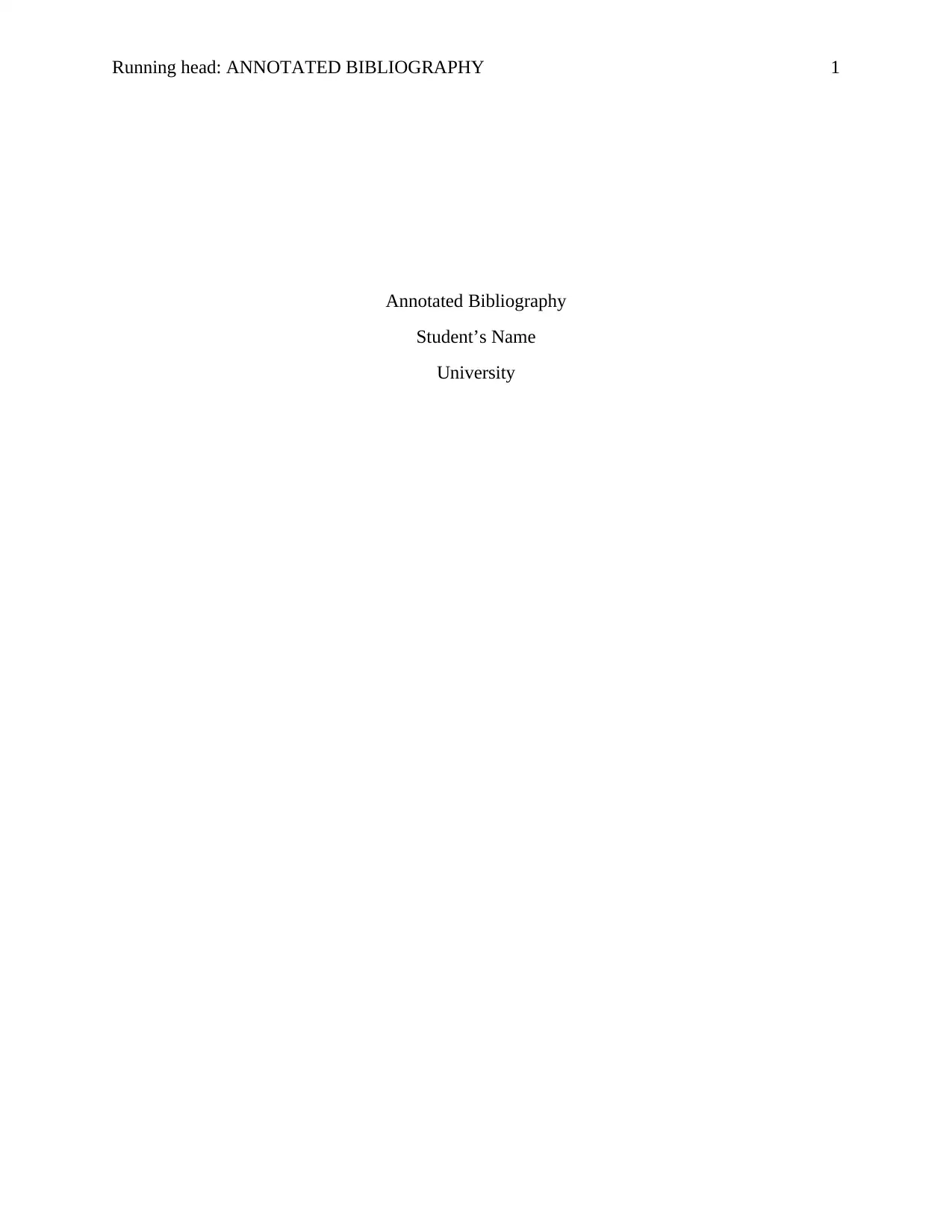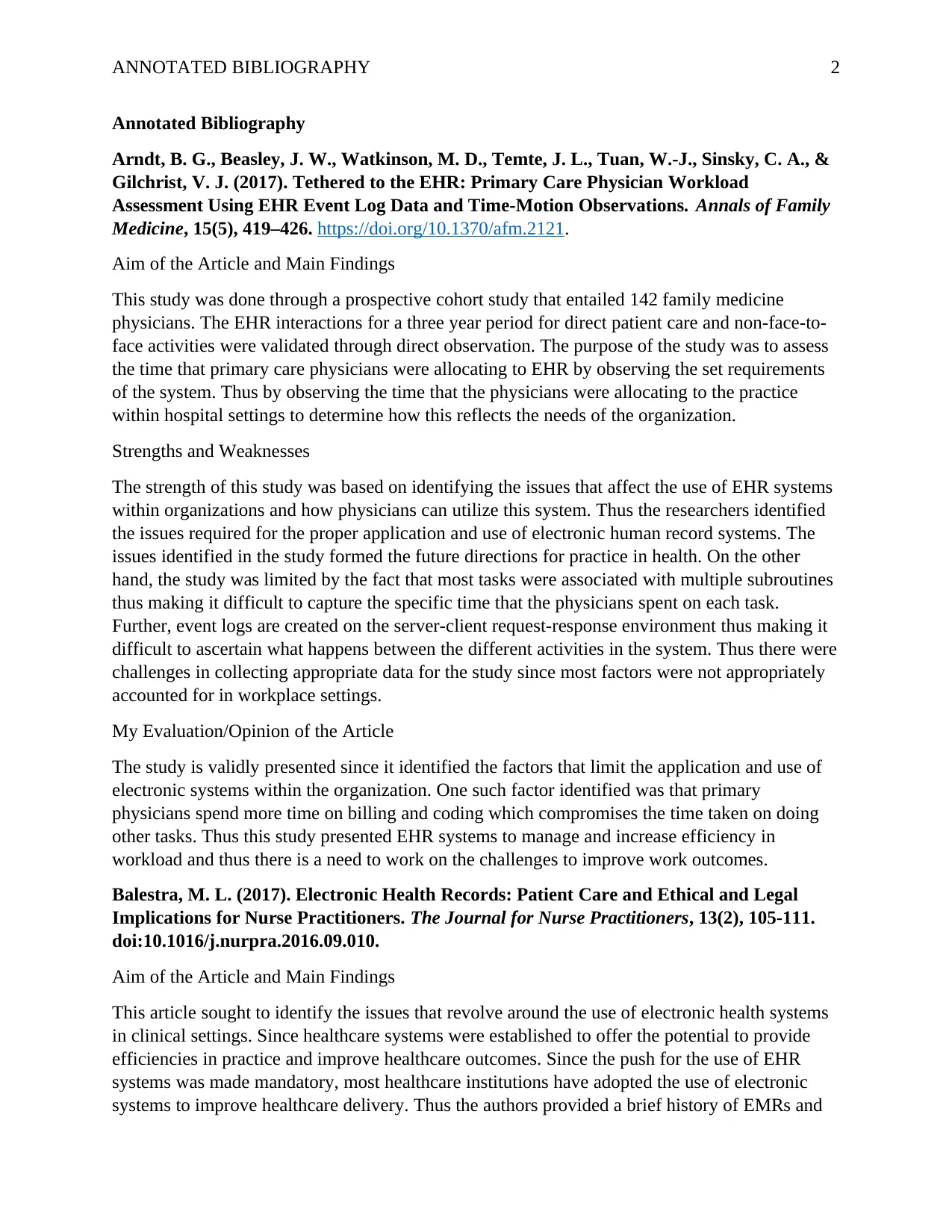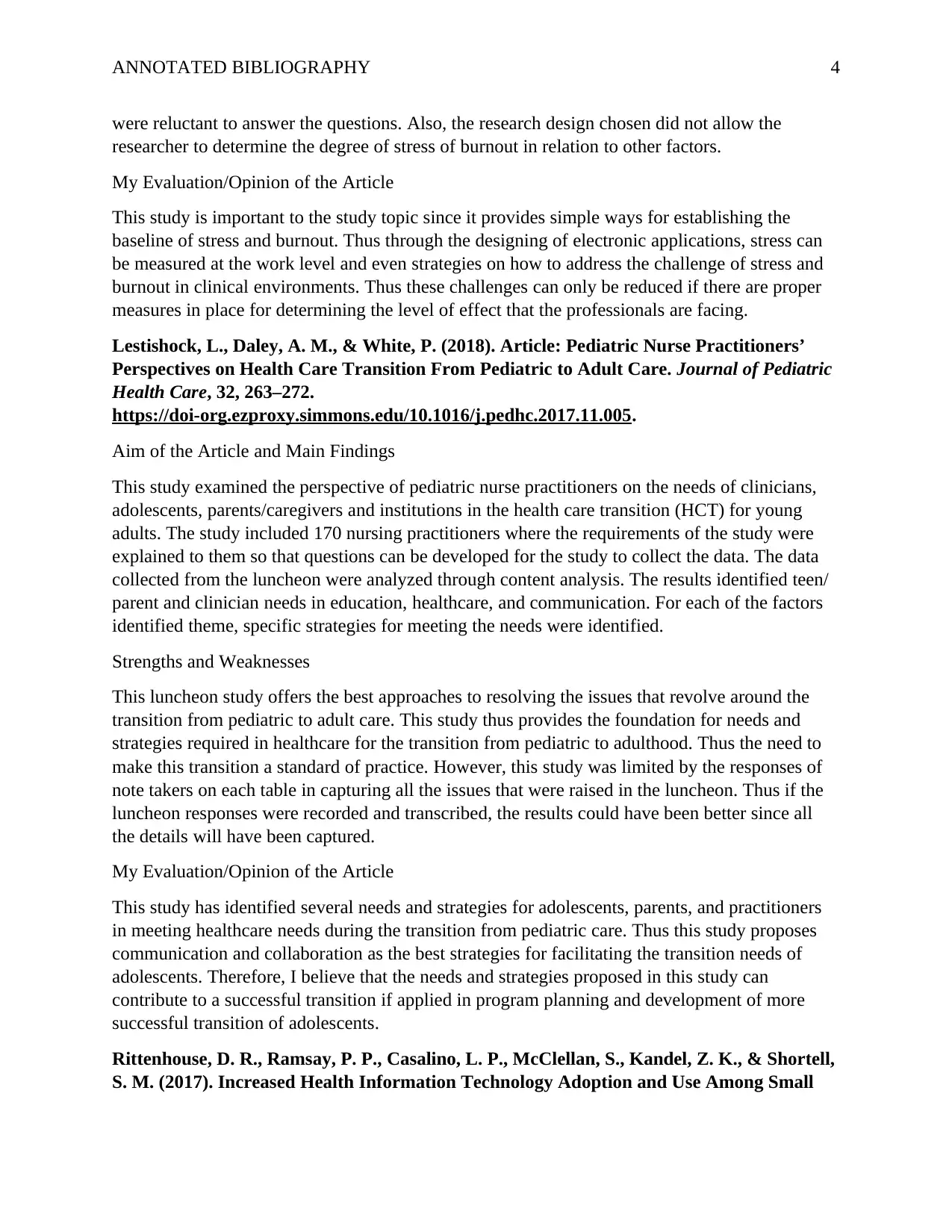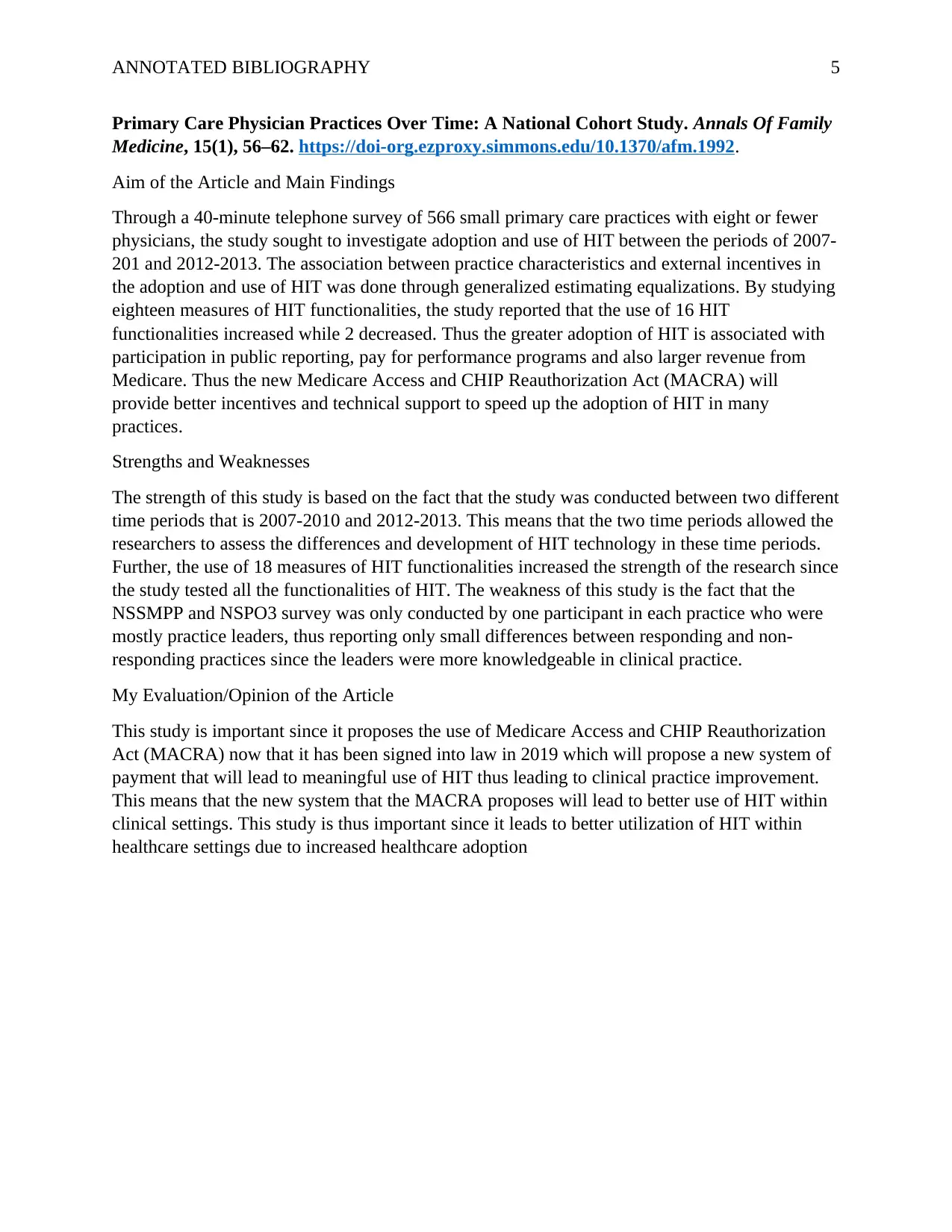Annotated Bibliography: Health Informatics and Physician Stress
VerifiedAdded on 2023/04/26
|5
|1966
|246
Annotated Bibliography
AI Summary
This annotated bibliography explores the impact of electronic health records (EHR) and health information technology (HIT) on physician workload, stress, and healthcare delivery. It includes summaries and evaluations of five articles. The first study assesses physician workload using EHR event log data, highlighting the time spent on direct patient care versus non-face-to-face activities. The second identifies ethical and legal implications of EHRs for nurse practitioners, emphasizing the need for training and competency development. The third quantifies the relationship between stress and HIT to predict physician burnout, suggesting strategies for remediation. The fourth examines pediatric nurse practitioners' perspectives on healthcare transition for young adults, focusing on education, healthcare systems, support, and communication. Finally, the fifth study investigates the adoption and use of HIT among small primary care practices, noting the association with public reporting and pay-for-performance programs, and suggesting the potential benefits of the Medicare Access and CHIP Reauthorization Act (MACRA) in promoting meaningful HIT use.

Running head: ANNOTATED BIBLIOGRAPHY 1
Annotated Bibliography
Student’s Name
University
Annotated Bibliography
Student’s Name
University
Paraphrase This Document
Need a fresh take? Get an instant paraphrase of this document with our AI Paraphraser

ANNOTATED BIBLIOGRAPHY 2
Annotated Bibliography
Arndt, B. G., Beasley, J. W., Watkinson, M. D., Temte, J. L., Tuan, W.-J., Sinsky, C. A., &
Gilchrist, V. J. (2017). Tethered to the EHR: Primary Care Physician Workload
Assessment Using EHR Event Log Data and Time-Motion Observations. Annals of Family
Medicine, 15(5), 419–426. https://doi.org/10.1370/afm.2121.
Aim of the Article and Main Findings
This study was done through a prospective cohort study that entailed 142 family medicine
physicians. The EHR interactions for a three year period for direct patient care and non-face-to-
face activities were validated through direct observation. The purpose of the study was to assess
the time that primary care physicians were allocating to EHR by observing the set requirements
of the system. Thus by observing the time that the physicians were allocating to the practice
within hospital settings to determine how this reflects the needs of the organization.
Strengths and Weaknesses
The strength of this study was based on identifying the issues that affect the use of EHR systems
within organizations and how physicians can utilize this system. Thus the researchers identified
the issues required for the proper application and use of electronic human record systems. The
issues identified in the study formed the future directions for practice in health. On the other
hand, the study was limited by the fact that most tasks were associated with multiple subroutines
thus making it difficult to capture the specific time that the physicians spent on each task.
Further, event logs are created on the server-client request-response environment thus making it
difficult to ascertain what happens between the different activities in the system. Thus there were
challenges in collecting appropriate data for the study since most factors were not appropriately
accounted for in workplace settings.
My Evaluation/Opinion of the Article
The study is validly presented since it identified the factors that limit the application and use of
electronic systems within the organization. One such factor identified was that primary
physicians spend more time on billing and coding which compromises the time taken on doing
other tasks. Thus this study presented EHR systems to manage and increase efficiency in
workload and thus there is a need to work on the challenges to improve work outcomes.
Balestra, M. L. (2017). Electronic Health Records: Patient Care and Ethical and Legal
Implications for Nurse Practitioners. The Journal for Nurse Practitioners, 13(2), 105-111.
doi:10.1016/j.nurpra.2016.09.010.
Aim of the Article and Main Findings
This article sought to identify the issues that revolve around the use of electronic health systems
in clinical settings. Since healthcare systems were established to offer the potential to provide
efficiencies in practice and improve healthcare outcomes. Since the push for the use of EHR
systems was made mandatory, most healthcare institutions have adopted the use of electronic
systems to improve healthcare delivery. Thus the authors provided a brief history of EMRs and
Annotated Bibliography
Arndt, B. G., Beasley, J. W., Watkinson, M. D., Temte, J. L., Tuan, W.-J., Sinsky, C. A., &
Gilchrist, V. J. (2017). Tethered to the EHR: Primary Care Physician Workload
Assessment Using EHR Event Log Data and Time-Motion Observations. Annals of Family
Medicine, 15(5), 419–426. https://doi.org/10.1370/afm.2121.
Aim of the Article and Main Findings
This study was done through a prospective cohort study that entailed 142 family medicine
physicians. The EHR interactions for a three year period for direct patient care and non-face-to-
face activities were validated through direct observation. The purpose of the study was to assess
the time that primary care physicians were allocating to EHR by observing the set requirements
of the system. Thus by observing the time that the physicians were allocating to the practice
within hospital settings to determine how this reflects the needs of the organization.
Strengths and Weaknesses
The strength of this study was based on identifying the issues that affect the use of EHR systems
within organizations and how physicians can utilize this system. Thus the researchers identified
the issues required for the proper application and use of electronic human record systems. The
issues identified in the study formed the future directions for practice in health. On the other
hand, the study was limited by the fact that most tasks were associated with multiple subroutines
thus making it difficult to capture the specific time that the physicians spent on each task.
Further, event logs are created on the server-client request-response environment thus making it
difficult to ascertain what happens between the different activities in the system. Thus there were
challenges in collecting appropriate data for the study since most factors were not appropriately
accounted for in workplace settings.
My Evaluation/Opinion of the Article
The study is validly presented since it identified the factors that limit the application and use of
electronic systems within the organization. One such factor identified was that primary
physicians spend more time on billing and coding which compromises the time taken on doing
other tasks. Thus this study presented EHR systems to manage and increase efficiency in
workload and thus there is a need to work on the challenges to improve work outcomes.
Balestra, M. L. (2017). Electronic Health Records: Patient Care and Ethical and Legal
Implications for Nurse Practitioners. The Journal for Nurse Practitioners, 13(2), 105-111.
doi:10.1016/j.nurpra.2016.09.010.
Aim of the Article and Main Findings
This article sought to identify the issues that revolve around the use of electronic health systems
in clinical settings. Since healthcare systems were established to offer the potential to provide
efficiencies in practice and improve healthcare outcomes. Since the push for the use of EHR
systems was made mandatory, most healthcare institutions have adopted the use of electronic
systems to improve healthcare delivery. Thus the authors provided a brief history of EMRs and

ANNOTATED BIBLIOGRAPHY 3
EHRs and at the same time identifies the concerns and issues that revolve around the adoption
and use of the systems in the organization.
Strengths and Weaknesses
The strength of this study is based on identifying the risks associated with the EHRs and EMRs
and at the same time proposes solutions for solving the challenges that healthcare professionals
face. The issues identified and the solutions presented form the basis for improving the viability
of electronic health record systems. However, this study was limited by the fact that it was a pure
literature review since it did not review the previous works of other studies but rather presented
the challenges that were presented by other studies. This means that the study should have been
based on systematic reviews of previous studies.
My Evaluation/Opinion of the Article
From the article, the challenges and weaknesses of electronic health record systems in hospitals
identified in the article are relevant since they provide the basis for evaluating the systems and
developing measures for addressing the challenges that systems face. Thus the researchers
suggested the need for training of practitioners to ensure that they develop proper competencies
for dealing with electronic health-related challenges. Thus through applying the
recommendations presented in the article, are important in ensuring that EHRs are properly
implemented in healthcare settings.
Gardner, R. L. rebekah_gardner@brown. ed., Cooper, E., Haskell, J., Harris, D. A.,
Poplau, S., Kroth, P. J., & Linzer, M. (2019). Physician stress and burnout: the impact of
health information technology. Journal of the American Medical Informatics
Association, 26(2), 106–114. https://doi-org.ezproxy.simmons.edu/10.1093/jamia/ocy145.
Aim of the Article and Main Findings
The article sought to quantify the relationship between stress and health information technology
to predict burnout in physicians. Through a survey of 4197 practicing physicians in Rhodes
Island, participants were asked to carry of out self-reporting of burn out level within their work
environment. A Likert scale was used to measure the level of burnout of the physicians where
the study found that identifying HIT-specific factors that relate to burnout can be easily
identified thus enabling organizations to remediate burnout among physicians and staff. This
study thus reports that there is a need to develop
Strengths and Weaknesses
One major strength that this study presents is the use or a complete statewide sample by
including many specialties and practices. Further, the questions used in the survey were validated
by physicians to include a variety of HIT-related questions on burn out. Further, through
regression techniques physician characteristics that independently associate with burn out and
minimize confounding were identified to increase the validity of the study. However, this study
is constrained by the fact that the physicians did not adequately quote their burnout levels or
EHRs and at the same time identifies the concerns and issues that revolve around the adoption
and use of the systems in the organization.
Strengths and Weaknesses
The strength of this study is based on identifying the risks associated with the EHRs and EMRs
and at the same time proposes solutions for solving the challenges that healthcare professionals
face. The issues identified and the solutions presented form the basis for improving the viability
of electronic health record systems. However, this study was limited by the fact that it was a pure
literature review since it did not review the previous works of other studies but rather presented
the challenges that were presented by other studies. This means that the study should have been
based on systematic reviews of previous studies.
My Evaluation/Opinion of the Article
From the article, the challenges and weaknesses of electronic health record systems in hospitals
identified in the article are relevant since they provide the basis for evaluating the systems and
developing measures for addressing the challenges that systems face. Thus the researchers
suggested the need for training of practitioners to ensure that they develop proper competencies
for dealing with electronic health-related challenges. Thus through applying the
recommendations presented in the article, are important in ensuring that EHRs are properly
implemented in healthcare settings.
Gardner, R. L. rebekah_gardner@brown. ed., Cooper, E., Haskell, J., Harris, D. A.,
Poplau, S., Kroth, P. J., & Linzer, M. (2019). Physician stress and burnout: the impact of
health information technology. Journal of the American Medical Informatics
Association, 26(2), 106–114. https://doi-org.ezproxy.simmons.edu/10.1093/jamia/ocy145.
Aim of the Article and Main Findings
The article sought to quantify the relationship between stress and health information technology
to predict burnout in physicians. Through a survey of 4197 practicing physicians in Rhodes
Island, participants were asked to carry of out self-reporting of burn out level within their work
environment. A Likert scale was used to measure the level of burnout of the physicians where
the study found that identifying HIT-specific factors that relate to burnout can be easily
identified thus enabling organizations to remediate burnout among physicians and staff. This
study thus reports that there is a need to develop
Strengths and Weaknesses
One major strength that this study presents is the use or a complete statewide sample by
including many specialties and practices. Further, the questions used in the survey were validated
by physicians to include a variety of HIT-related questions on burn out. Further, through
regression techniques physician characteristics that independently associate with burn out and
minimize confounding were identified to increase the validity of the study. However, this study
is constrained by the fact that the physicians did not adequately quote their burnout levels or
⊘ This is a preview!⊘
Do you want full access?
Subscribe today to unlock all pages.

Trusted by 1+ million students worldwide

ANNOTATED BIBLIOGRAPHY 4
were reluctant to answer the questions. Also, the research design chosen did not allow the
researcher to determine the degree of stress of burnout in relation to other factors.
My Evaluation/Opinion of the Article
This study is important to the study topic since it provides simple ways for establishing the
baseline of stress and burnout. Thus through the designing of electronic applications, stress can
be measured at the work level and even strategies on how to address the challenge of stress and
burnout in clinical environments. Thus these challenges can only be reduced if there are proper
measures in place for determining the level of effect that the professionals are facing.
Lestishock, L., Daley, A. M., & White, P. (2018). Article: Pediatric Nurse Practitioners’
Perspectives on Health Care Transition From Pediatric to Adult Care. Journal of Pediatric
Health Care, 32, 263–272.
https://doi-org.ezproxy.simmons.edu/10.1016/j.pedhc.2017.11.005.
Aim of the Article and Main Findings
This study examined the perspective of pediatric nurse practitioners on the needs of clinicians,
adolescents, parents/caregivers and institutions in the health care transition (HCT) for young
adults. The study included 170 nursing practitioners where the requirements of the study were
explained to them so that questions can be developed for the study to collect the data. The data
collected from the luncheon were analyzed through content analysis. The results identified teen/
parent and clinician needs in education, healthcare, and communication. For each of the factors
identified theme, specific strategies for meeting the needs were identified.
Strengths and Weaknesses
This luncheon study offers the best approaches to resolving the issues that revolve around the
transition from pediatric to adult care. This study thus provides the foundation for needs and
strategies required in healthcare for the transition from pediatric to adulthood. Thus the need to
make this transition a standard of practice. However, this study was limited by the responses of
note takers on each table in capturing all the issues that were raised in the luncheon. Thus if the
luncheon responses were recorded and transcribed, the results could have been better since all
the details will have been captured.
My Evaluation/Opinion of the Article
This study has identified several needs and strategies for adolescents, parents, and practitioners
in meeting healthcare needs during the transition from pediatric care. Thus this study proposes
communication and collaboration as the best strategies for facilitating the transition needs of
adolescents. Therefore, I believe that the needs and strategies proposed in this study can
contribute to a successful transition if applied in program planning and development of more
successful transition of adolescents.
Rittenhouse, D. R., Ramsay, P. P., Casalino, L. P., McClellan, S., Kandel, Z. K., & Shortell,
S. M. (2017). Increased Health Information Technology Adoption and Use Among Small
were reluctant to answer the questions. Also, the research design chosen did not allow the
researcher to determine the degree of stress of burnout in relation to other factors.
My Evaluation/Opinion of the Article
This study is important to the study topic since it provides simple ways for establishing the
baseline of stress and burnout. Thus through the designing of electronic applications, stress can
be measured at the work level and even strategies on how to address the challenge of stress and
burnout in clinical environments. Thus these challenges can only be reduced if there are proper
measures in place for determining the level of effect that the professionals are facing.
Lestishock, L., Daley, A. M., & White, P. (2018). Article: Pediatric Nurse Practitioners’
Perspectives on Health Care Transition From Pediatric to Adult Care. Journal of Pediatric
Health Care, 32, 263–272.
https://doi-org.ezproxy.simmons.edu/10.1016/j.pedhc.2017.11.005.
Aim of the Article and Main Findings
This study examined the perspective of pediatric nurse practitioners on the needs of clinicians,
adolescents, parents/caregivers and institutions in the health care transition (HCT) for young
adults. The study included 170 nursing practitioners where the requirements of the study were
explained to them so that questions can be developed for the study to collect the data. The data
collected from the luncheon were analyzed through content analysis. The results identified teen/
parent and clinician needs in education, healthcare, and communication. For each of the factors
identified theme, specific strategies for meeting the needs were identified.
Strengths and Weaknesses
This luncheon study offers the best approaches to resolving the issues that revolve around the
transition from pediatric to adult care. This study thus provides the foundation for needs and
strategies required in healthcare for the transition from pediatric to adulthood. Thus the need to
make this transition a standard of practice. However, this study was limited by the responses of
note takers on each table in capturing all the issues that were raised in the luncheon. Thus if the
luncheon responses were recorded and transcribed, the results could have been better since all
the details will have been captured.
My Evaluation/Opinion of the Article
This study has identified several needs and strategies for adolescents, parents, and practitioners
in meeting healthcare needs during the transition from pediatric care. Thus this study proposes
communication and collaboration as the best strategies for facilitating the transition needs of
adolescents. Therefore, I believe that the needs and strategies proposed in this study can
contribute to a successful transition if applied in program planning and development of more
successful transition of adolescents.
Rittenhouse, D. R., Ramsay, P. P., Casalino, L. P., McClellan, S., Kandel, Z. K., & Shortell,
S. M. (2017). Increased Health Information Technology Adoption and Use Among Small
Paraphrase This Document
Need a fresh take? Get an instant paraphrase of this document with our AI Paraphraser

ANNOTATED BIBLIOGRAPHY 5
Primary Care Physician Practices Over Time: A National Cohort Study. Annals Of Family
Medicine, 15(1), 56–62. https://doi-org.ezproxy.simmons.edu/10.1370/afm.1992.
Aim of the Article and Main Findings
Through a 40-minute telephone survey of 566 small primary care practices with eight or fewer
physicians, the study sought to investigate adoption and use of HIT between the periods of 2007-
201 and 2012-2013. The association between practice characteristics and external incentives in
the adoption and use of HIT was done through generalized estimating equalizations. By studying
eighteen measures of HIT functionalities, the study reported that the use of 16 HIT
functionalities increased while 2 decreased. Thus the greater adoption of HIT is associated with
participation in public reporting, pay for performance programs and also larger revenue from
Medicare. Thus the new Medicare Access and CHIP Reauthorization Act (MACRA) will
provide better incentives and technical support to speed up the adoption of HIT in many
practices.
Strengths and Weaknesses
The strength of this study is based on the fact that the study was conducted between two different
time periods that is 2007-2010 and 2012-2013. This means that the two time periods allowed the
researchers to assess the differences and development of HIT technology in these time periods.
Further, the use of 18 measures of HIT functionalities increased the strength of the research since
the study tested all the functionalities of HIT. The weakness of this study is the fact that the
NSSMPP and NSPO3 survey was only conducted by one participant in each practice who were
mostly practice leaders, thus reporting only small differences between responding and non-
responding practices since the leaders were more knowledgeable in clinical practice.
My Evaluation/Opinion of the Article
This study is important since it proposes the use of Medicare Access and CHIP Reauthorization
Act (MACRA) now that it has been signed into law in 2019 which will propose a new system of
payment that will lead to meaningful use of HIT thus leading to clinical practice improvement.
This means that the new system that the MACRA proposes will lead to better use of HIT within
clinical settings. This study is thus important since it leads to better utilization of HIT within
healthcare settings due to increased healthcare adoption
Primary Care Physician Practices Over Time: A National Cohort Study. Annals Of Family
Medicine, 15(1), 56–62. https://doi-org.ezproxy.simmons.edu/10.1370/afm.1992.
Aim of the Article and Main Findings
Through a 40-minute telephone survey of 566 small primary care practices with eight or fewer
physicians, the study sought to investigate adoption and use of HIT between the periods of 2007-
201 and 2012-2013. The association between practice characteristics and external incentives in
the adoption and use of HIT was done through generalized estimating equalizations. By studying
eighteen measures of HIT functionalities, the study reported that the use of 16 HIT
functionalities increased while 2 decreased. Thus the greater adoption of HIT is associated with
participation in public reporting, pay for performance programs and also larger revenue from
Medicare. Thus the new Medicare Access and CHIP Reauthorization Act (MACRA) will
provide better incentives and technical support to speed up the adoption of HIT in many
practices.
Strengths and Weaknesses
The strength of this study is based on the fact that the study was conducted between two different
time periods that is 2007-2010 and 2012-2013. This means that the two time periods allowed the
researchers to assess the differences and development of HIT technology in these time periods.
Further, the use of 18 measures of HIT functionalities increased the strength of the research since
the study tested all the functionalities of HIT. The weakness of this study is the fact that the
NSSMPP and NSPO3 survey was only conducted by one participant in each practice who were
mostly practice leaders, thus reporting only small differences between responding and non-
responding practices since the leaders were more knowledgeable in clinical practice.
My Evaluation/Opinion of the Article
This study is important since it proposes the use of Medicare Access and CHIP Reauthorization
Act (MACRA) now that it has been signed into law in 2019 which will propose a new system of
payment that will lead to meaningful use of HIT thus leading to clinical practice improvement.
This means that the new system that the MACRA proposes will lead to better use of HIT within
clinical settings. This study is thus important since it leads to better utilization of HIT within
healthcare settings due to increased healthcare adoption
1 out of 5
Related Documents
Your All-in-One AI-Powered Toolkit for Academic Success.
+13062052269
info@desklib.com
Available 24*7 on WhatsApp / Email
![[object Object]](/_next/static/media/star-bottom.7253800d.svg)
Unlock your academic potential
Copyright © 2020–2025 A2Z Services. All Rights Reserved. Developed and managed by ZUCOL.





